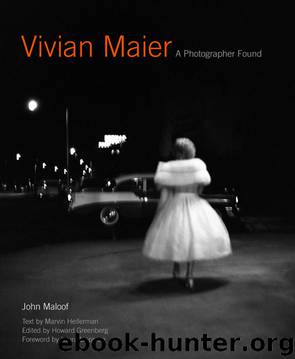Vivian Maier: A Photographer Found by John Maloof

Author:John Maloof [Maloof, John]
Language: eng
Format: azw3
Publisher: HarperCollins
Published: 2014-10-28T04:00:00+00:00
Chicago’s Marina City apartments towers nearing completion. Chicago, 1963.
Chicago, like New York, was an image-driven city in which photography played a prominent role. In 1955, the locally based Chicago Defender newspaper and Jet magazine, two prominent African-American publications, printed the photographs of young Chicagoan Emmett Till’s battered body, helping to galvanize the civil rights movement. That same year, creatives at the Leo Burnett advertising agency introduced the Marlboro Man campaign, in which self-consciously mythic photographs played a prominent role.
Chicago was where celebrities such as Frank Sinatra, Judy Garland, Bette Davis, and Clark Gable, in the years before jet travel became commonplace, changed trains on their coast-to-coast journeys, signing autographs, sipping cocktails in the Pump Room, and striking poses for photographers, including Maier, before heading on to New York or Hollywood. The Art Institute of Chicago was gaining national distinction for its mounting of photographic exhibitions. During Maier’s first decade in the area, the museum showed the work of Margaret Bourke-White, Life photographer Lisa Larsen, Edward Weston, Dorothea Lange, Frederick Sommer, Inge Morath, Aaron Siskind, Imogen Cunningham, Walker Evans, and Bruce Davidson, among others. By the late 1950s, the Institute of Design, where both Harry Callahan and Siskind were on the faculty, was widely recognized as one of the most adventurous and influential photography schools in the United States.
Early in his career, Callahan, who liked to make daily photographic forays in the city, wrote a grant application proposing “to photograph as I felt and desired; to regulate a pleasant form of living.” From the look of Maier’s Chicago work, while she photographed as instinctively and maybe even as often as Callahan did, pleasantness doesn’t seem to have factored in strongly as a goal. Callahan made lovely and, mostly, serene photographs. Maier’s Chicago was a tougher, more ambivalent place.
Downtown Chicago was one of the primary locales where Maier explored what mattered to her, in photographs that ranged from lyrical to harsh, from appreciative to anxious. Those same qualities are evident, too, in the pictures she made away from the city center, in or near the homes where she worked. Those images were often of the children she spent her days with, the activities they engaged in, the places they went. Shot indoors in family rooms or outside in yards and tree-lined neighborhoods safe to wander, these images mostly depict a comfortable world where late-model cars were parked in driveways, roses blossomed in gardens, and kids played outdoors on sunny summer days.
But Maier made melancholic photographs during snowstorms, when winter wonderlands turned claustrophobic. Pictures of roofers and repairmen coming and going, of a Cadillac being towed away, of a raccoon trapped on a front lawn suggest that even the good life has its share of bumps. Kids routinely populate Maier’s pictures, watching television, building backyard forts, playing at the beach. But Maier—a caring person, but an unsentimental photographer—was just as quick to photograph children when they were crying or vulnerable. For her, everyone and everything was fair game. One day, for example, when
Download
This site does not store any files on its server. We only index and link to content provided by other sites. Please contact the content providers to delete copyright contents if any and email us, we'll remove relevant links or contents immediately.
Shoot Sexy by Ryan Armbrust(17564)
Portrait Mastery in Black & White: Learn the Signature Style of a Legendary Photographer by Tim Kelly(16877)
Adobe Camera Raw For Digital Photographers Only by Rob Sheppard(16805)
Photographically Speaking: A Deeper Look at Creating Stronger Images (Eva Spring's Library) by David duChemin(16504)
Bombshells: Glamour Girls of a Lifetime by Sullivan Steve(13701)
Art Nude Photography Explained: How to Photograph and Understand Great Art Nude Images by Simon Walden(12858)
Perfect Rhythm by Jae(5080)
Pillow Thoughts by Courtney Peppernell(4031)
The Book of Joy by Dalai Lama(3710)
Good by S. Walden(3360)
The Pixar Touch by David A. Price(3225)
A Dictionary of Sociology by Unknown(2864)
Fantastic Beasts: The Crimes of Grindelwald by J. K. Rowling(2853)
Stacked Decks by The Rotenberg Collection(2699)
Humans of New York by Brandon Stanton(2694)
Read This If You Want to Take Great Photographs by Carroll Henry(2609)
On Photography by Susan Sontag(2494)
Photographic Guide to the Birds of Indonesia by Strange Morten;(2412)
Insomniac City by Bill Hayes(2404)
